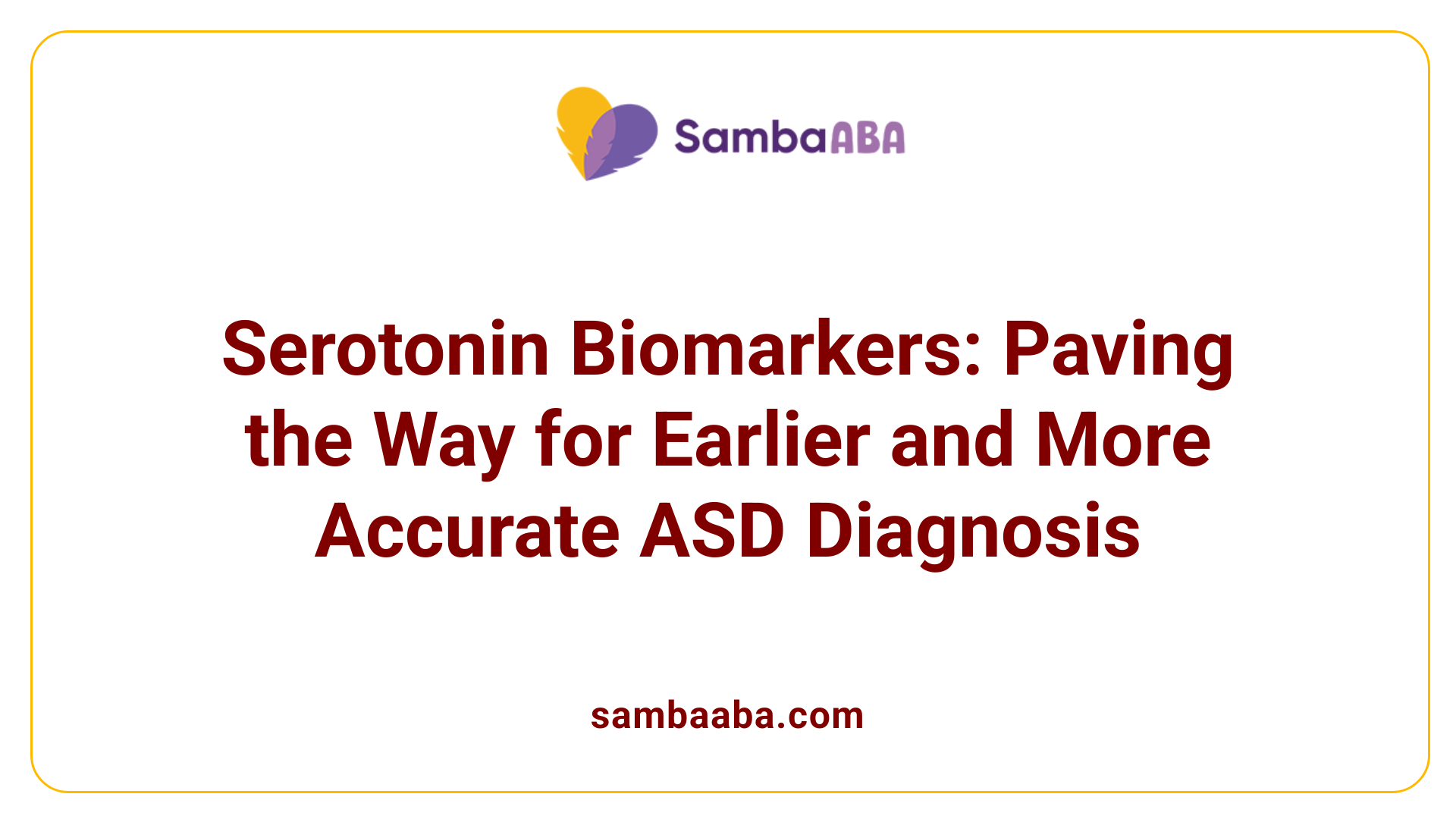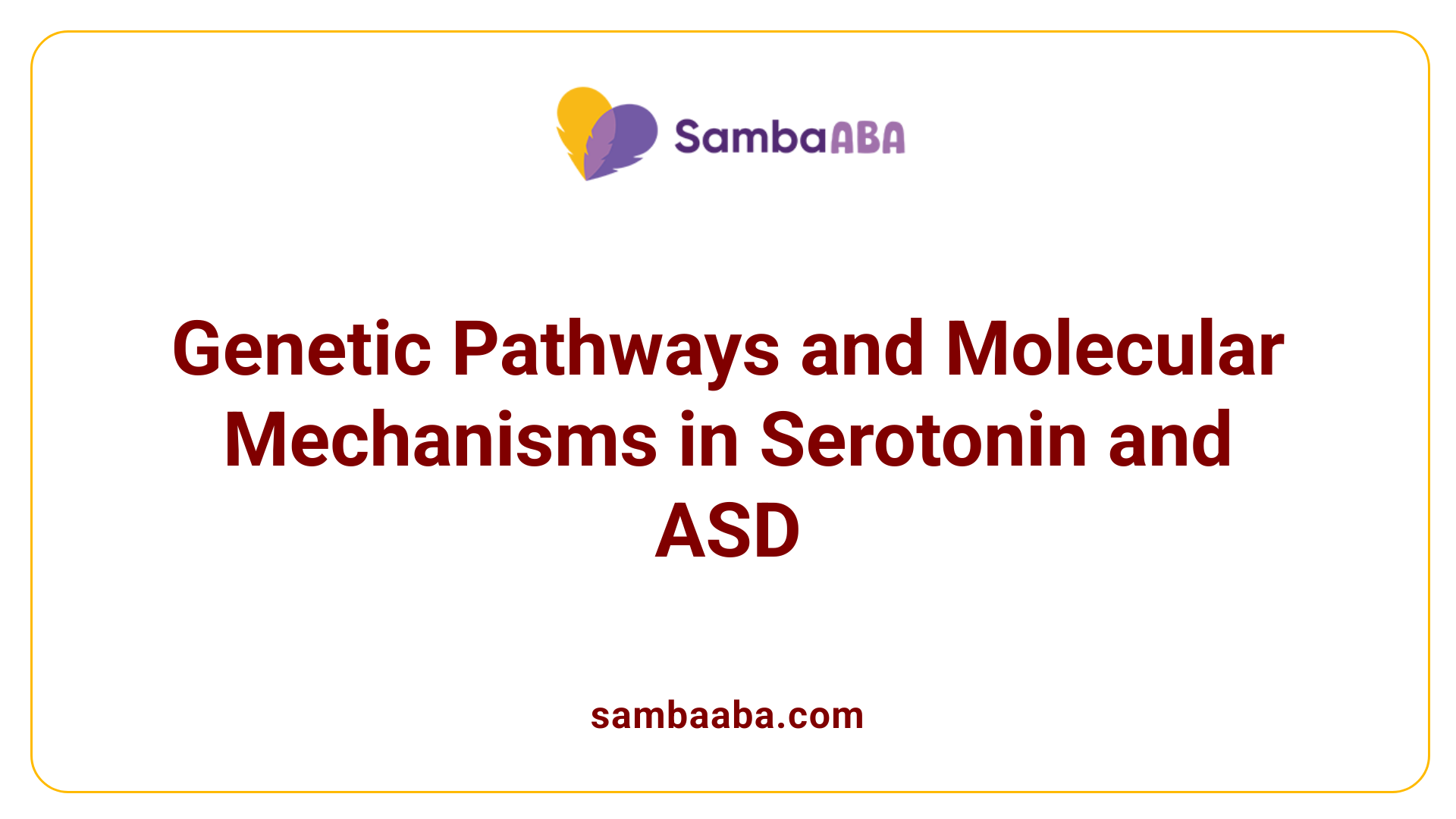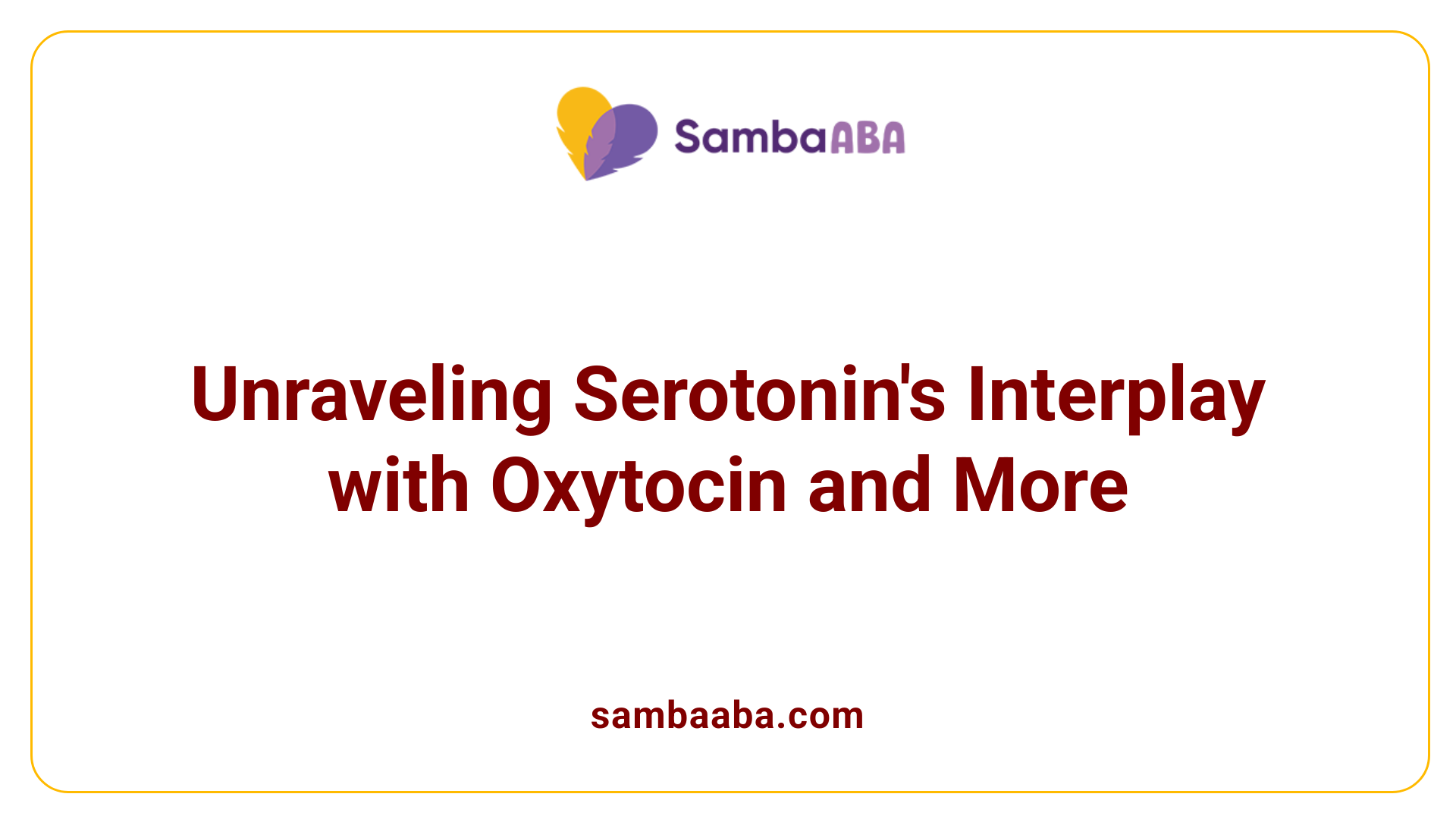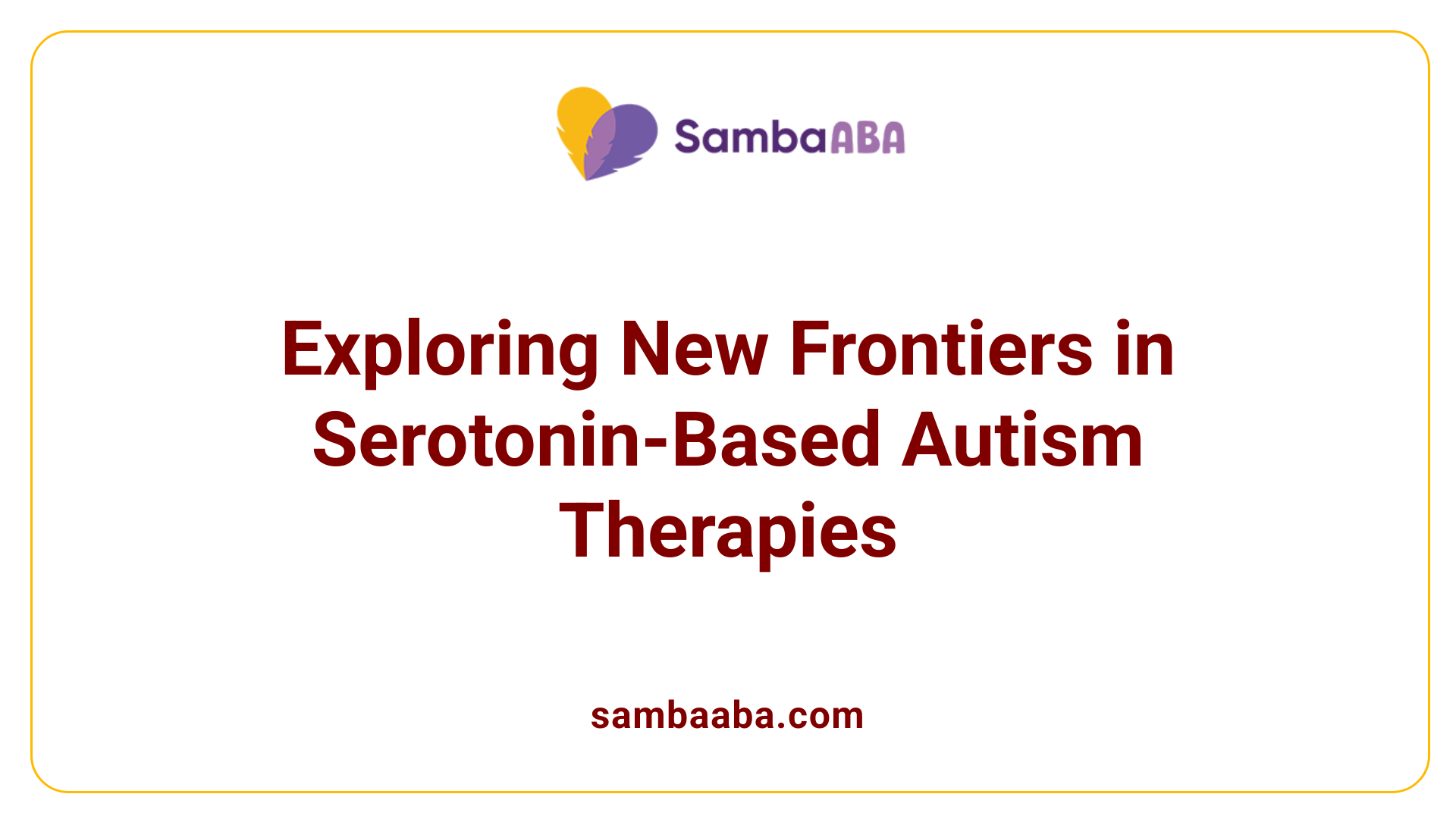Serotonin and Autism
Unraveling the Complex Role of Serotonin in Autism Spectrum Disorder
Understanding the Neurochemical Foundations of ASD
Autism spectrum disorder (ASD) encompasses a range of neurodevelopmental conditions characterized by social communication challenges, stigma, and repetitive behaviors. Central to recent research is the neurotransmitter serotonin, which plays a pivotal role in brain development, emotional regulation, and social behaviors. This article explores how variations in serotonin levels and system functioning contribute to the neurobiological and behavioral features of autism, and how this knowledge could foster targeted interventions.
Serotonin as a Biomarker in Autism Spectrum Disorder

What are potential biomarkers involving serotonin for autism?
Serotonin-related biomarkers are increasingly recognized as important tools for autism spectrum disorder (ASD) research and diagnosis. Elevated blood serotonin levels, known as hyperserotonemia, are present in more than 25% of children with ASD, making it the most consistent biomarker identified in the disorder. This trait is heritable, with studies indicating that blood serotonin levels show greater genetic influence than ASD itself and are linked to recurrence risk within families.
Research also points to abnormalities in the serotonin system reflected in neuroimaging and postmortem studies. Variations in the serotonin transporter (SERT) gene, especially rare amino acid variants associated with increased serotonin uptake, suggest a genetic basis for serotonergic dysregulation. Animal models with genetic modifications in SERT mimic hyperserotonemia and display ASD-like behaviors, reinforcing the biological relevance.
Furthermore, disruptions in the serotonergic pathway—such as altered synthesis, receptor function, and transport—are being explored as potential biomarkers. These include increased platelet serotonin levels and altered receptor binding patterns, which could serve as diagnostic or prognostic indicators. Current research also explores biomarkers within broader serotonergic pathways, like N-acetylserotonin and melatonin levels, that reflect serotonergic imbalance.
Summary: Blood serotonin levels, genetic variants in the serotonin transporter, and neurobiological alterations in serotonin pathways are promising biomarkers for ASD, aiding in early diagnosis and personalized treatment approaches.
What behaviors are associated with variations in serotonin levels?
Serotonin affects a wide range of social and emotional behaviors. Elevated serotonin activity, often reflected in increased blood levels, correlates with prosocial behaviors such as cooperation and social bonding. Conversely, decreased serotonergic activity is linked to antisocial tendencies, like aggression and social withdrawal.
In autism, variations in serotonin levels influence core symptoms and behaviors. Increased serotonin levels are associated with stereotyped and repetitive behaviors, hallmark features of ASD. These behaviors may stem from altered receptor signaling, particularly involving receptors such as 5HT2A and 5HT7, which modulate neural circuits governing motor and behavioral rigidity.
Serotonin also impacts moral decision-making and harm aversion—higher levels tend to increase reluctance to accept harm to others, whereas depletion can lead to more permissiveness toward aggressive acts. Additionally, gene polymorphisms affecting the serotonin transporter, like SLC6A4, influence personality traits including impulsivity, neuroticism, and aggression, further linking serotonin to behavioral variability.
Overall, fluctuations in serotonin levels contribute significantly to individual differences in social-emotional functioning, with relevant implications for ASD behavioral profiles.
What is the relationship between serotonin levels and autism spectrum disorder?
The relationship between serotonin and ASD is multifaceted. A prominent feature is hyperserotonemia—elevated blood serotonin levels—found in roughly a quarter of individuals with autism. This trait has been observed since the 1960s and remains one of the most consistent biological markers linked to ASD.
Genetic studies implicate the serotonin transporter gene (SERT, SLC6A4), where variants and rare mutations lead to increased serotonin uptake, influencing blood serotonin levels and potentially modulating severity and specific behaviors in ASD.
Additionally, brain serotonin concentrations tend to be lower in affected individuals, especially in regions involved in social cognition like the prefrontal and limbic areas. Neuroimaging studies reveal decreased serotonin transporter availability and receptor binding, aligning with these biochemical alterations.
Altered serotonin signaling affects neurodevelopment by influencing neuronal migration, synapse formation, and circuit maturation. This contributes to core ASD features such as social deficits, repetitive behaviors, and sensory abnormalities.
While therapeutic approaches targeting the serotonin system—like SSRIs—offer some symptom relief, their benefits are variable, underscoring the complex role of serotonin in ASD pathophysiology.
What neurobiological differences involving serotonin are observed in individuals with autism?
Research has identified several neurobiological differences related to serotonin in ASD. Blood studies consistently show hyperserotonemia, with elevated levels of 5-HT especially in platelets, which are the primary peripheral source of serotonin.
Neuroimaging techniques, such as PET scans, reveal decreased serotonin transporter (SERT) levels in critical brain areas, including the cortex and limbic regions, correlating with social and cognitive impairments.
Postmortem examinations support these findings, showing alterations in serotonin receptor density and expression. Particularly, decreased activity at 5HT2A receptors and changes in serotonergic innervation patterns have been documented.
Genetic studies further reveal mutations in genes regulating serotonin, such as SERT and related transporters, that influence serotonin availability and synaptic functioning.
Animal models with SERT mutations demonstrate behavioral traits reminiscent of ASD, such as reduced social interactions and increased repetitive behaviors, emphasizing the role of serotonin dysregulation.
In sum, a combination of peripheral, central, genetic, and neuroimaging findings points to significant serotonin system alterations underlying ASD.
What is known about serotonin's role in the development and symptoms of autism?
Serotonin has a crucial role during neural development, influencing neuron formation, migration, and synaptic connectivity. Abnormal serotonin levels during fetal development can lead to altered brain structure and function, contributing to ASD symptoms.
Elevated maternal serotonin levels, particularly during pregnancy, have been linked to increased autism risk in offspring. Animal models show that manipulating serotonin levels can affect neurogenesis and connectivity, with excess or deficit resulting in behavioral anomalies.
In developing brains, serotonin shapes circuits involved in social cognition, sensory processing, and executive functions. Disruptions can manifest as social withdrawal, repetitive behaviors, and communication difficulties.
Postnatal alterations, including reduced serotonin transporter availability and receptor activity, further influence ongoing neural plasticity and behavior.
Overall, serotonergic dysregulation during critical developmental periods underpins many ASD features, making it a central focus of etiological research.
How do imaging and neurological studies shed light on serotonin system alterations in autism?
Advanced neuroimaging techniques like PET and MRI have been instrumental in visualizing serotonergic abnormalities in ASD. PET imaging with radiolabeled ligands shows decreased serotonin transporter binding in the frontal, temporal, and cingulate cortices, regions vital for social and cognitive functions.
Multiple studies confirm reduced transporter availability, especially in adults, correlating with impairments in social cognition tests such as the Faux Pas Test.
Postmortem analyses support these findings, revealing alterations in transporter and receptor densities, and abnormal serotonergic innervation patterns.
Further, neurochemical studies reveal that blood serotonin levels are elevated in a subset of ASD individuals, confirming peripheral system involvement and supporting the hypothesis of systemic serotonergic imbalance.
Overall, neuroimaging and cellular studies reinforce that serotonergic dysregulation—both centrally and peripherally—plays a significant role in ASD pathology.
What are the implications of serotonin research for autism treatment?
Insights from serotonin research open new avenues for targeted therapies in ASD. The identification of hyperserotonemia in a substantial subset of patients suggests that modulating the serotonergic system could alleviate core symptoms.
While traditional treatments like SSRIs have shown mixed results, focusing on specific serotonin receptor subtypes—such as 5HT1A, 5HT2A, and 5HT7—may offer more precise interventions.
Animal studies demonstrate that receptor-specific agonists or antagonists can improve social behaviors and reduce repetitive actions, guiding the development of novel pharmacological agents.
Additionally, understanding serotonergic pathways helps tailor interventions, including considering maternal serotonin levels during pregnancy, which could influence fetal neural development.
Lastly, integrating genetic biomarkers, such as SERT variants, with neurochemical profiles could optimize personalized treatment strategies, potentially improving outcomes for subsets of individuals with ASD.
In conclusion, ongoing research advances the prospect of more effective, targeted therapies that modulate serotonergic mechanisms, improving quality of life for those affected.
Genetic and Molecular Insights into Serotonin’s Role in ASD

What is known about genetic and neurochemical factors related to serotonin and autism?
Research shows that the serotonergic system plays a significant role in autism spectrum disorder (ASD) at both genetic and neurochemical levels. Blood serotonin levels, particularly hyperserotonemia—elevated serotonin in the blood—is present in more than 25% of children with autism. These elevated levels are heritable, with studies indicating that blood serotonin has a greater heritability than ASD itself, and are associated with recurrence risks in families.
Genetic studies have consistently pointed to the region on chromosome 17 containing the serotonin transporter gene (SERT or SLC6A4). Variants of the SERT gene, especially amino acid mutations like Gly56Ala, can lead to increased serotonin uptake, influencing serum serotonin levels. Animal models with these mutations exhibit behaviors reminiscent of ASD, such as social deficits and repetitive behaviors, providing neurochemical insights into the disorder.
Emerging neuroimaging and postmortem studies further reveal alterations in the brain’s serotonin system in individuals with ASD. Reduced serotonin transporter (5-HTT) availability in key brain regions correlates with social cognitive impairments, supporting the hypothesis that serotonergic dysregulation contributes to core symptoms of autism.
How do genetic variants in serotonin-related genes impact ASD?
Genetic variants in serotonin-related genes influence the synthesis, transport, and metabolism of serotonin, thereby affecting neurodevelopment and behavior. Variants in the SLC6A4 gene can lead to increased reuptake of serotonin, resulting in hyperserotonemia observed in a subset of autistic individuals. Similarly, mutations in the TPH2 gene, which encodes tryptophan hydroxylase 2 — the enzyme responsible for serotonin synthesis in the brain — may alter serotonin production.
Rare amino acid substitutions in the SERT gene, such as Gly56Ala, have been linked to increased serotonin transporter activity. This disrupts normal serotonin signaling by prematurely clearing serotonin from synapses, which can impair neural development and lead to behavioral features associated with autism.
Family studies and linkage analyses consistently point to the SERT gene on chromosome 17 as a major genetic factor. These findings suggest that inheritable variants affecting serotonergic pathways predispose individuals to ASD, especially among males, who exhibit a higher prevalence of certain genetic susceptibility loci.
What do animal models reveal about the genetic basis of serotonin's involvement in ASD?
Animal models have been instrumental in elucidating the genetic contribution of serotonin to ASD. Mice engineered to carry the human-equivalent Gly56Ala mutation in the SERT gene exhibit hallmark traits such as hyperserotonemia and behavioral abnormalities.
These models display reduced social interaction, increased repetitive behaviors, and communication deficits, mirroring core aspects of autism. They provide direct evidence that specific genetic changes in serotonin transport mechanisms can cause neurobehavioral abnormalities.
Furthermore, these models help demonstrate how increased serotonin reuptake alters brain circuitry, affecting social and cognitive functions. They also serve as a platform for testing potential pharmacological interventions aiming to correct serotonergic imbalances.
In summary, genetic alterations influencing serotonin transport and synthesis are central to understanding autism’s biological underpinnings. Animal models carrying relevant mutations highlight how these genetic factors can disrupt neurodevelopment and manifest as ASD-like behaviors, reinforcing the importance of serotonergic pathways in the disorder.
Neurochemical Interactions and Developmental Insights
What do we know about serotonin's role in brain development and autism?
Serotonin (5-HT) plays a crucial role during fetal brain development, acting as a fundamental neuromodulator in shaping neural circuitry. It influences processes such as neuronal formation, migration, and synapse development—key steps in establishing functional brain networks.
Disruptions in serotonin levels during these early stages can lead to structural and functional abnormalities associated with autism spectrum disorder (ASD). For example, abnormal serotonin concentrations in the fetal environment, whether elevated or decreased, may alter the formation of neural pathways critical for social cognition, sensory processing, and emotional regulation.
Research indicates that maternal serotonin levels are particularly influential. Elevated maternal serotonin, known as hyperserotonemia, has been linked to autism in some offspring, especially when children lack rare genetic variants associated with ASD. Conversely, low brain serotonin levels are also implicated, affecting neurotransmission and brain connectivity.
During critical neurodevelopmental periods, serotonin acts as a modulator, guiding the growth and differentiation of neural circuits. Interference with this process can result in the characteristic behaviors of ASD, such as impaired social interactions and sensory sensitivities.
Furthermore, maternal serotonin levels, influenced by genetic, dietary, or environmental factors, may impact neural pathways involved in social behavior and cognitive flexibility. High maternal serotonin might disrupt normal fetal development, contributing to atypical brain wiring, whereas inadequate serotonin could hinder proper neuronal maturation.
Emerging neuroimaging and postmortem studies support this, showing alterations in the serotonergic system in individuals with ASD. Changes include reduced serotonin transporter (SERT) availability in various brain regions and fluctuations in serotonin receptor expression, which further underline serotonin’s role in neurodevelopmental trajectories.
Understanding these mechanisms is essential, as it opens new avenues for early detection and potential intervention. Modulating serotonin levels during pregnancy—potentially through nutritional or pharmacological means—might influence neurodevelopmental outcomes.
Therefore, the state of serotonin during fetal development appears to be a critical factor; deviations from optimal levels can have long-lasting effects on brain structure and function, ultimately contributing to the behavioral profiles observed in ASD.
Interactions Between Serotonin and Other Neurochemical Systems

What are the interactions between serotonin and oxytocin systems in autism?
Research indicates that serotonin and oxytocin, two critical neurochemical systems involved in social behavior, do not operate in isolation. Instead, they interact in ways that may influence the social deficits observed in autism spectrum disorder (ASD).
There is evidence of reciprocal interactions between the serotonin and oxytocin systems. These interactions suggest that dysregulation in one can impact the other, thereby influencing social behaviors characteristic of ASD.
Oxytocin, often dubbed the ‘social bonding hormone,’ is synthesized in the paraventricular nucleus of the hypothalamus. It projects to limbic brain regions such as the ventral tegmental area (VTA), nucleus accumbens (NAcc), and amygdala. These areas are heavily involved in processing social information, emotional regulation, and decision-making.
In children with autism, studies consistently report lower levels of oxytocin compared to neurotypical controls. This reduction may contribute to the impairments in social communication and bonding.
The interaction between serotonergic and oxytocin pathways appears to play a substantial role in modulating social behaviors. Serotonin influences oxytocin release and receptor sensitivity, while oxytocin can modulate serotonergic activity. This interconnectedness suggests that disturbances in either system might exacerbate social deficits.
One therapeutic approach that exemplifies this interaction is intranasal oxytocin administration. Clinical studies have shown that delivering oxytocin through the nasal route can increase activity in brain regions involved in visual social processing, such as the occipital and fusiform gyri. These regions are crucial for recognizing and interpreting social cues like facial expressions.
Animal models further support this interplay. In rodent studies of ASD, oxytocin administration has been shown to improve social deficits. These findings reinforce the notion that enhancing oxytocin signaling can positively influence social behavior.
In summary, the synergy between serotonin and oxytocin systems is essential for normal social functioning. Disruptions in their interaction could underlie some of the core social impairments in ASD. Understanding these interactions offers promising targets for developing treatments aimed at improving social cognition and behaviors in affected individuals.
How does serotonergic dysregulation influence social behavior?
Serotonin’s role extends beyond mood regulation, significantly impacting social cognition and interactions. In individuals with ASD, abnormal serotonin levels—either excess or deficiency—can correlate with social impairments.
Elevated blood serotonin levels, known as hyperserotonemia, are present in about 25% of children with autism. Conversely, some studies suggest that brain serotonin concentrations, especially in certain regions like the prefrontal cortex, might be reduced, impairing neurotransmission.
Altered serotonin receptor function, particularly at subtypes such as 5HT2A and 5HT1A, can influence social behaviors. Modifying these receptor activities with specific drugs has shown potential to improve social and repetitive behaviors, indicating that serotonergic dysregulation directly impacts social functioning.
Genetic variants affecting the serotonin transporter (SERT), such as mutations in the SLC6A4 gene, can disrupt serotonin availability. These variants often lead to increased blood serotonin levels and are linked to autism traits.
Recent neuroimaging studies reveal decreased serotonin transporter binding in key brain regions associated with social cognition, like the cingulate cortex. This reduction correlates with poor performance on social cognition tests, emphasizing serotonin’s role in facilitating social understanding.
In animal models, genetic manipulations that alter serotonin transporter activity lead to behaviors reminiscent of ASD, such as impaired social interactions and communication.
Overall, serotonergic dysregulation—whether through abnormal blood or brain levels, receptor activity, or transporter function—contributes significantly to the social deficits observed in ASD. Targeting serotonergic pathways, therefore, holds promise for developing therapies aimed at alleviating social impairments in autism.
| Aspect | Explanation | Related Findings |
|---|---|---|
| Blood serotonin (5-HT) levels | Elevated in some autistic children | 25-30% show hyperserotonemia |
| Brain serotonin levels | Often reduced in specific regions | Associated with impaired social cognition |
| Serotonin receptors | Dysfunction at 5HT2A, 5HT1A | Modulation can improve behaviors |
| Serotonin transporter (SERT) | Variants affect serotonin availability | Mutations linked to ASD traits |
| Neuroimaging findings | Decreased serotonin transporter binding | Correlates with social impairments |
Understanding the interactions between serotonin and oxytocin systems, as well as the impact of serotonergic dysregulation, highlights the complexity of neurochemical influences on social behavior in ASD. These insights foster ongoing research on targeted therapeutic strategies to improve social functioning in affected individuals.
Therapeutic Horizons and Future Directions in Serotonin Research

What are the implications of serotonin research for autism treatment?
Research on serotonin has opened promising avenues for understanding and treating autism spectrum disorder (ASD). One of the notable findings is the high prevalence of hyperserotonemia, or elevated blood serotonin levels, in over 25% of individuals with autism. This biomarker not only helps in identifying specific subgroups of ASD but also guides targeted interventions focused on the serotonergic system.
The serotonin system influences several neurodevelopmental and behavioral processes critical to ASD, including social interaction, sensory processing, and cognitive flexibility. Different receptor subtypes such as 5-HT1, 5-HT2, 5-HT6, and 5-HT7 are involved in modulating these behaviors. Experimental treatments that specifically target these receptors—using selective or biased ligands—have shown promise in preclinical models. For instance, receptor-specific drugs have demonstrated potential in reducing stereotyped behaviors and improving social functioning, suggesting that pharmacologically fine-tuning serotonin activity could alleviate core ASD symptoms.
Furthermore, genetic studies highlight the role of the serotonin transporter (SERT) gene variants in influencing blood serotonin levels and associated behaviors. These genetic insights support the development of precision medicine approaches, where treatments are tailored based on individual genetic and biomarker profiles.
In addition to direct neural effects, serotonin's role in the gut-brain axis has garnered increasing attention. Serotonin produced in the gastrointestinal tract interacts with brain function and is involved in gastrointestinal issues often seen in ASD, as well as stereotyped behaviors. Modulating gut microbiota and serotonin signaling pathways offers a comprehensive strategy to address both behavioral and physical symptoms.
Current clinical trials and findings
Multiple clinical trials are actively exploring serotonergic drugs for ASD. Some study the efficacy of selective serotonin reuptake inhibitors (SSRIs) in reducing repetitive behaviors and anxiety in children and adolescents, though the findings have been mixed, and safety remains a concern. Other trials focus on receptor-specific agents, aiming to improve social communication and cognitive flexibility with fewer side effects.
Recent research indicates that measuring blood serotonin levels, combined with neuroimaging data, can improve diagnosis and help gauge treatment response. For example, elevated serum serotonin levels have shown a high specificity for identifying certain ASD subgroups, especially when correlated with regional serotonin transporter availability in the brain.
Despite the promise, there are challenges—such as variability in individual responses and incomplete understanding of serotonin’s diverse roles across brain regions and developmental stages—that highlight the need for further research.
Microbiome and gut-brain axis involvement
Emerging evidence emphasizes the importance of the gut-brain axis in ASD, with gut microbiota influencing serotonin production and regulation. The majority of body serotonin is produced in the gut by enterochromaffin cells, which can affect neurological functions. Alterations in gut microbiota composition have been linked to changes in serotonin synthesis and receptor expression, potentially impacting ASD symptoms.
Interventions that modify the microbiome—such as probiotics, diet, and prebiotics—aim to restore healthy serotonin signaling and reduce gastrointestinal and behavioral symptoms. Some studies are exploring how microbiome modulation impacts serotonin levels, emphasizing the interconnectedness of gut health and brain function.
Future directions
Moving forward, research efforts are focusing on integrating biomarker data (such as blood serotonin and SERT levels), genetic profiles, and neuroimaging to develop personalized treatments. Advances in receptor-specific drugs and understanding the role of the microbiome could lead to more targeted, effective therapies with fewer side effects.
The intersection of serotonergic and oxytocin systems also remains a promising research area, as their bidirectional interactions influence social behavior—a core challenge in ASD.
Overall, the evolving landscape of serotonin research holds substantial promise for transforming ASD diagnosis and treatment, emphasizing personalized medicine that considers biological, genetic, and environmental factors.
Summary and Future Perspectives
The intricate relationship between serotonin and ASD involves abnormal blood levels, receptor activity, genetic factors, and neurodevelopmental pathways. As research continues to unravel these complex mechanisms, serotonin remains a promising biomarker and therapeutic target. Advances in neuroimaging, genetics, and pharmacology pave the way for more personalized and effective interventions, emphasizing the importance of multidisciplinary approaches. Future studies focusing on maternal serotonin levels, early biomarkers, and novel drugs targeting serotonergic systems hold the potential to transform ASD diagnosis and treatment, moving closer to tailored therapies that address the neurochemical roots of this condition.
References
- The serotonin system in autism spectrum disorder: from biomarker to ...
- Serotonin's link to autism, explained - The Transmitter
- Oxytocin and serotonin in the modulation of neural function - Frontiers
- Shedding Light on the Link between Maternal Serotonin and Autism
- Serotonin and serotonin transporter levels in autistic children - PMC
- Serotonin transporter availability in adults with autism—a positron ...
- Is There a Relationship Between Serotonin and Autism? - Harkla
- Blood serotonin levels in autism spectrum disorder: A systematic ...
- Autism spectrum disorder associated with low serotonin in CSF and ...
